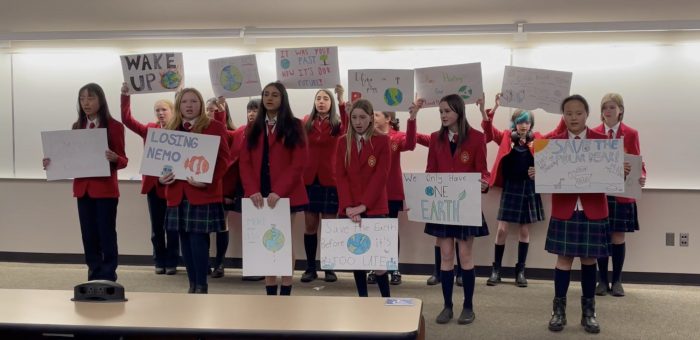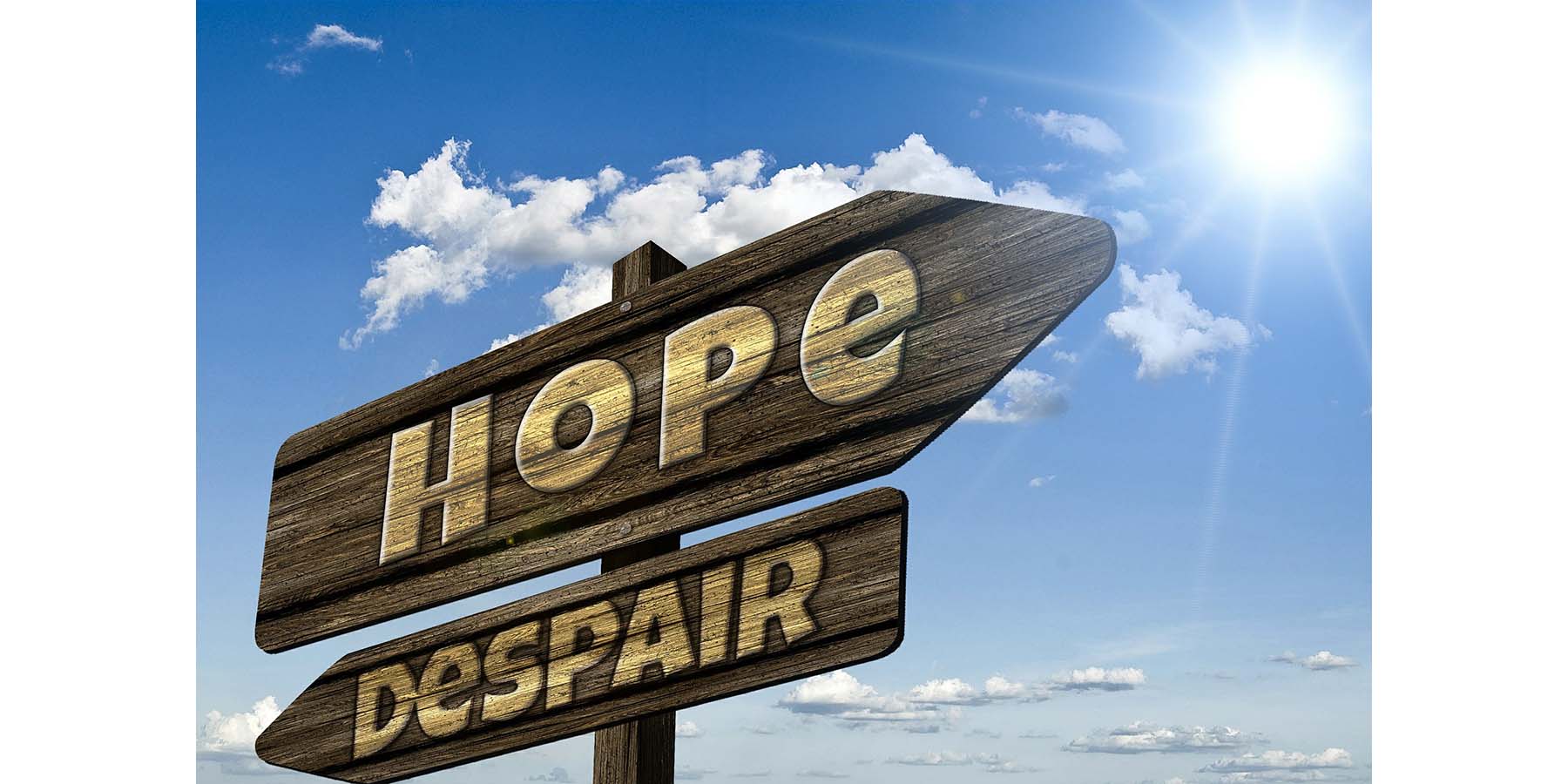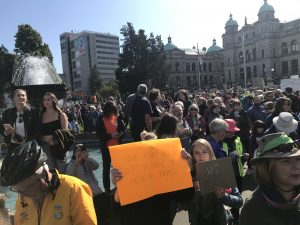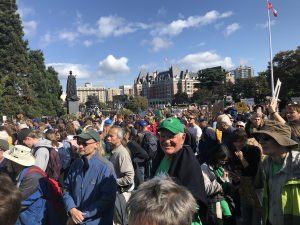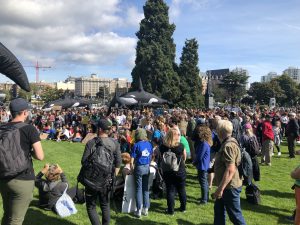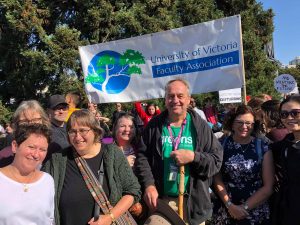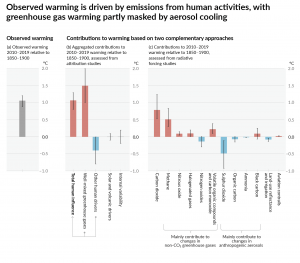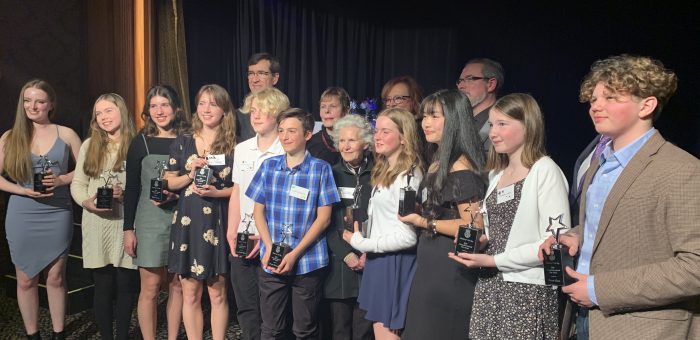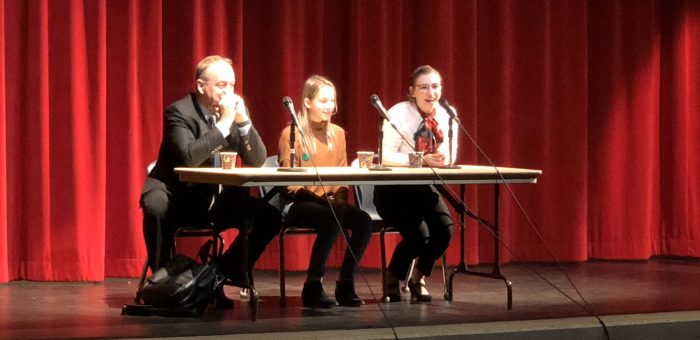Youth
Global warming: An intergenerational conversation and plea for action
In February I penned an article arguing that fear-based climate messaging often drives people to despondency and apathy rather than climate action. In this post, I’d like to offer a counter example of how positive, thoughtful climate messaging can inspire people to want to do better. I am grateful to the students and teachers at St. Margaret’s school, Minister George Heyman and the students in my EOS 365 (Climate and Society) class for participating and contributing to an intergenerational conversation on climate change on Monday, March 4, 2024.
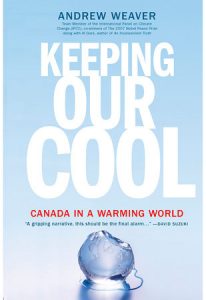 EOS 365 (Climate and Society) is a course I developed at UVic and first offered in 2009. The lectures follow the chapters in the book Keeping Our Cool: Canada in a Warming World that I first published in 2008. In the course I survey the climate system and its interaction with past, present, and future societies, including the onset of agriculture/domestication of animals in the Holocene, the rise and fall of early civilizations, the Anthropocene and global warming. Early in the course I teach a module on science communication. I emphasize that if one wants to advance lasting climate solutions, then one must bring people with you rather than alienating those who may not wish to prioritize climate action. I point out that politicians are elected to represent everyone, not just their support base, and so policy makers need to listen and respond to the views of all stakeholders.
EOS 365 (Climate and Society) is a course I developed at UVic and first offered in 2009. The lectures follow the chapters in the book Keeping Our Cool: Canada in a Warming World that I first published in 2008. In the course I survey the climate system and its interaction with past, present, and future societies, including the onset of agriculture/domestication of animals in the Holocene, the rise and fall of early civilizations, the Anthropocene and global warming. Early in the course I teach a module on science communication. I emphasize that if one wants to advance lasting climate solutions, then one must bring people with you rather than alienating those who may not wish to prioritize climate action. I point out that politicians are elected to represent everyone, not just their support base, and so policy makers need to listen and respond to the views of all stakeholders.
I also suggest to the students that whether or not society wants to deal with global warming really boils down to one question:
Do we the present generation owe anything to future generations in terms of the quality of the environment we leave behind. Yes? or No?
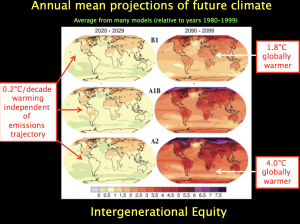 Science can’t answer that question. But science tells us why this is ultimately the question that needs to be asked. If the answer is yes, then we have no choice but to immediately take steps to decarbonize energy systems for the consequences of unchecked emission growth are profound (widespread species extinction and unparalleled geopolitical instability). If the answer is no, then who cares about global warming?
Science can’t answer that question. But science tells us why this is ultimately the question that needs to be asked. If the answer is yes, then we have no choice but to immediately take steps to decarbonize energy systems for the consequences of unchecked emission growth are profound (widespread species extinction and unparalleled geopolitical instability). If the answer is no, then who cares about global warming?
In class I also note that formulating climate policy is often inconsistent with a four year political cycle as the effects of the policy decisions made today will not be felt in the political lifetime of those making the decisions. Yet these same politicians will not be around in the future to be held accountable for the decisions they did or did not make. And so policies with demonstrable short-term outcomes often take precedence over climate policy. Allocating resources to advance short term “wins” will allow you to point to your political successes in a few years and proclaim “I was responsive to your needs; please re-elect me and I will do more”. It’s next to impossible to do the same with climate policy. But I would argue that there is a moral and ethical imperative to advance climate solutions now if society believes in the importance of intergenerational equity.
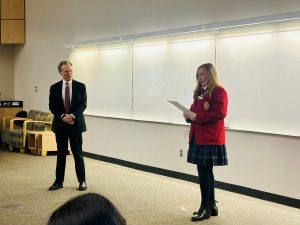 Building on the themes of effective climate communication and intergenerational equity, I hosted an event in EOS 365 on March 4 inspired by the Grade 7 (and 8) students at St. Margaret’s School, Victoria BC. Four generations were involved in the conversation: 1) the St. Margaret’s students; 2) the UVic students; 3) the teachers from St. Margaret’s; 4) the Honourable George Heyman (Minister of Environment and Climate Change Strategy) and me.
Building on the themes of effective climate communication and intergenerational equity, I hosted an event in EOS 365 on March 4 inspired by the Grade 7 (and 8) students at St. Margaret’s School, Victoria BC. Four generations were involved in the conversation: 1) the St. Margaret’s students; 2) the UVic students; 3) the teachers from St. Margaret’s; 4) the Honourable George Heyman (Minister of Environment and Climate Change Strategy) and me.
On February 1 2024, I attended St. Margaret’s Grade 7 Environmental Summit and was blown away by the insight and creativity of the students. The Grade 7 class had been learning about the socioeconomic and environmental ramifications of global warming. Students took on the role of an affected party (e.g. firefighter, fisher, pilot, business owner etc.) and researched how global warming was going to affect them. I listened to numerous testimonies from the Grade 7 students who role-played their chosen characters and was taken aback by their insight and how effectively, and articulately they were able to communicate their stories.
The highlight of the event for me was was when the Grade 7/8 St. Margaret’s choir sang a rendition of an SOS from the kids in front of all those in attendance.
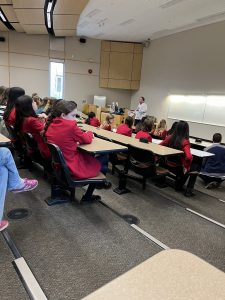 My March 4 class began with the St. Margaret’s grade 7/8 choir, led by Mike Keddy, setting the tone for the rest of our conversation by once more singing an SOS from the kids. At the end of the song, and as the final words “you can do better than this” were sung, Mike Keddy held up a Montreal Canadians pennant (indeed one can do better than that).
My March 4 class began with the St. Margaret’s grade 7/8 choir, led by Mike Keddy, setting the tone for the rest of our conversation by once more singing an SOS from the kids. At the end of the song, and as the final words “you can do better than this” were sung, Mike Keddy held up a Montreal Canadians pennant (indeed one can do better than that).
We were keeping things light and continuing the playful banter that had started at St. Margaret’s School when I noticed middle years teacher Michael Jones had decorated his classroom with some Edmonton Oilers swag. Michael arrived at my class wearing his Oilers jersey, while the TA for the class Katherine Martin proudly sported a Toronto Maple Leafs sweater. She was joined by middle years teacher and fellow Leaf’s fan Meaghan Thompson who showed up with a Leaf’s cap.
And of course, while noting the obvious irony, I adorned my Oilers jersey.
We were honoured to have Minister Heyman attend the class. He had just announced that he was not seeking reelection in the next provincial election moments before we started, and EOS 365 was his first public appearance following that announcement. Once the choir had finished, Minister Heyman spoke about CleanBC and how is government was responding to the challenge of global warming and capitalizing on the opportunity it provides for innovation and creativity in addressing the challenge.
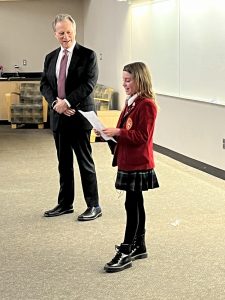 In advance of the class I had given six EOS 365 students copies of the scripts that were going to be read out (see the instagram reel at the end of this post). All six of these students were from the first cohort enrolled in UVic’s new BSc in Climate Science degree program. Each of these students asked the Minister a thoughtful yet probing question that they had prepared in advance and based on the script they were given. The Minister responded in an equally thoughtful way. I role-played the Speaker, and offered the class a supplementary question which was subsequently posed to the Minister. And so we proceeded to explore how the BC government was responding to climate change in six unique sectors.
In advance of the class I had given six EOS 365 students copies of the scripts that were going to be read out (see the instagram reel at the end of this post). All six of these students were from the first cohort enrolled in UVic’s new BSc in Climate Science degree program. Each of these students asked the Minister a thoughtful yet probing question that they had prepared in advance and based on the script they were given. The Minister responded in an equally thoughtful way. I role-played the Speaker, and offered the class a supplementary question which was subsequently posed to the Minister. And so we proceeded to explore how the BC government was responding to climate change in six unique sectors.
This particular class was perhaps the most enriching and rewarding experience I’ve ever had while teaching at the university level. And I started teaching in 1986! My sincere thanks to the students and teachers at St. Margaret’s School, the Minister and his staff, and the BSc in Climate Science and other students in EOS 365 for making this event so successful.
My hope in organizing this event was to demonstrate to my class how positive, hopeful, constructive and solutions-focused climate communication can inspire others to want to take climate action. Too often, activists use fear-based messaging, or outrageous acts of civil disobedience, like throwing soup on a priceless Van Gogh or disrupting traffic and creating chaos on local streets in an attempt to raise awareness as to the seriousness of climate change. As I have argued before, more often than not, such behaviour does little more than drive people to despondency and apathy rather than climate action.
View this post on Instagram
When ideology trumps evidence: The decision to cancel the school liaison officer program in School District 61
On May 31, 2023 and in what can only be described as a textbook example of ideological decision-based evidence-making, Trustees voted unanimously to cancel the school liaison officer (SLO) program in all School District 61 (SD61) schools (the only school district in BC to do so). The Vancouver School Board, which had previously eliminated school liaison officers in 2021, reinstated them in September 2023.
Remarkably, the SD61 decision was reached without consultation with any Police Board in the region or the leadership of either the Esquimalt or Songhees First Nations. In support of their decision, School Board Chair, and former BC Green candidate for Oak Bay-Gordon Head, Nicole Duncan demonstrated a fundamental misunderstanding of the role of SLOs and the community policing model (ironically in a community she wanted to represent in the BC Legislature) by stating “Police are being asked to fill in gaps in student support and to take on roles that should be filled by individuals with specialized expertise, such as youth and family counsellors and social workers“.
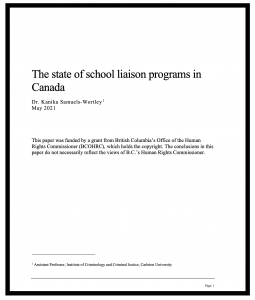 The SD61 decision built on a bizarre press release issued by the BC Office of the Human Rights Commissioner on November 22, 2022: Letter to school trustees on human rights concerns with the use of School Liaison Officers in B.C. schools. While obviously an overreach of the mandate of the unelected BC Human Rights Commissioner, she stated “I strongly recommend that all school districts end the use of SLOs until the impact of these programs can be established empirically. ” I was serving on the the Oak Bay Police Board at the time and was very familiar with Oak Bay’s community policing model and the important preventative role that school liaison officers play in such a model. I had hoped the Human Rights Commissioner letter was supported by extensive research on SLOs in BC Schools. Sadly, all that I could find was a single report commissioned by her office known as the Samuels-Wortley report.
The SD61 decision built on a bizarre press release issued by the BC Office of the Human Rights Commissioner on November 22, 2022: Letter to school trustees on human rights concerns with the use of School Liaison Officers in B.C. schools. While obviously an overreach of the mandate of the unelected BC Human Rights Commissioner, she stated “I strongly recommend that all school districts end the use of SLOs until the impact of these programs can be established empirically. ” I was serving on the the Oak Bay Police Board at the time and was very familiar with Oak Bay’s community policing model and the important preventative role that school liaison officers play in such a model. I had hoped the Human Rights Commissioner letter was supported by extensive research on SLOs in BC Schools. Sadly, all that I could find was a single report commissioned by her office known as the Samuels-Wortley report.
I thoroughly reviewed the Samuels-Wortley report. It provides a literature review of studies pertaining to SLO programs in Canada and the United States. First, it’s important to note that the author states on page 3 of her report “an extensive review of the literature reveals no peer-reviewed studies that explore the impacts of Canadian SLO programs on marginalized students.” In fact, one of the five peer-reviewed Canadian studies the author found pertaining to Canadian SLOs suggested positive outcomes when introduced as a component of a community policing model (Broll and Howells, 2019).
 The US-based research reviewed in the Samuels-Wrotley report focussed on the “school-to-prison” pipeline, violence, US-based SLO training protocol etc. and cannot be generalized to Canada. Even the Toronto Police internal evaluation reviewed in the Samuels-Wortley report is not generalizable to Greater Victoria as they were assessing a targetted SLO program introduced after the fatal shooting of a student at a Toronto high school, not as a key component of a community-policing framework.
The US-based research reviewed in the Samuels-Wrotley report focussed on the “school-to-prison” pipeline, violence, US-based SLO training protocol etc. and cannot be generalized to Canada. Even the Toronto Police internal evaluation reviewed in the Samuels-Wortley report is not generalizable to Greater Victoria as they were assessing a targetted SLO program introduced after the fatal shooting of a student at a Toronto high school, not as a key component of a community-policing framework.
The SD61 decision was also supported by a thoroughly debunked letter from the Greater Victoria Teacher’s Association who had apparently not surveyed their members before coming up with their supposedly (but clearly not) researched ideological position. On the other hand, the Victoria Principals’ and Vice Principals’ Association, whose members are in charge of individual school management wrote a strong letter of support for SLOs to the Board of Trustees that was apparently ignored.
What’s most odd about the GVTA letter is that in April 2018, when I was serving in the BC Legislature as the MLA for Oak Bay-Gordon Head, Victoria Police cut their SLO program after not being given the resources to maintain their frontline services. By December 2018, the Greater Victoria Teacher’s Association began a campaign to get police liaison officer’s back in Victoria Schools that continued into 2019 as school-based incidents started to rise. The GVTA’s dramatic policy lurch strikes me as a textbook example of what happens when one or two idealogues start ramming through their agenda while claiming to speak on behalf of the collective.
 Rather than choosing to consult with those delivering or providing oversight into the SLO program, School Board Trustees seemed to be swayed by those purporting to have uncovered gotcha evidence from FOI information they received. The egregious misinformation brought forward in this regard provided the “evidence” to support the ideological narrative needed to justify a predetermined decision (so-called decision-based evidence-making) to eliminate SLOs from SD61 schools. For example, on X (formerly known as Twitter), one activist offered gotcha ‘proof’ that VicPD were targeting members of the BIPOC community. They pointed out that 19% of all “youth suspects” arrested by VicPD were indigenous whereas only 5% of the population was indigenous. What they failed to point out was that the data they were looking at was aggregate rather than individual data. To illustrate this, suppose there were 100 arrests & one BIPOC individual committed 19 of them. Suppose the other 81 were committed by 81 different other folk. Then the statistic is only 1.2% of people VicPD labeled as “youth suspects” were BIPOC. Perhaps the activists would have served our community better if they educated themselves on the data before making incorrect assertions.
Rather than choosing to consult with those delivering or providing oversight into the SLO program, School Board Trustees seemed to be swayed by those purporting to have uncovered gotcha evidence from FOI information they received. The egregious misinformation brought forward in this regard provided the “evidence” to support the ideological narrative needed to justify a predetermined decision (so-called decision-based evidence-making) to eliminate SLOs from SD61 schools. For example, on X (formerly known as Twitter), one activist offered gotcha ‘proof’ that VicPD were targeting members of the BIPOC community. They pointed out that 19% of all “youth suspects” arrested by VicPD were indigenous whereas only 5% of the population was indigenous. What they failed to point out was that the data they were looking at was aggregate rather than individual data. To illustrate this, suppose there were 100 arrests & one BIPOC individual committed 19 of them. Suppose the other 81 were committed by 81 different other folk. Then the statistic is only 1.2% of people VicPD labeled as “youth suspects” were BIPOC. Perhaps the activists would have served our community better if they educated themselves on the data before making incorrect assertions.
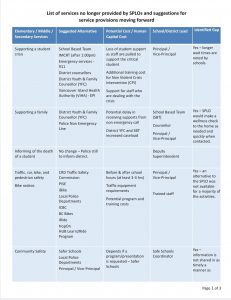 In another example, a powerpoint presentation to a School District committee on SLOs seemed to have been particularly influential even though none of the purported “gotcha” statistics were checked with VicPD and most were misinterpreted. Sadly with gangs now having increased access to schools, vulnerable youth become easy victims for grooming into gang life. But that’s not the only consequence of the irresponsible School Board decision. Here’s an incomplete list of what the Board has identified as services the SLOs used to provide that now fall into the responsibility of already overburdened principals and vice-principals, along with the District’s lone Safe Schools Coordinator. This list also illustrates the challenges faced by schools and students since the removal of the SLOs.
In another example, a powerpoint presentation to a School District committee on SLOs seemed to have been particularly influential even though none of the purported “gotcha” statistics were checked with VicPD and most were misinterpreted. Sadly with gangs now having increased access to schools, vulnerable youth become easy victims for grooming into gang life. But that’s not the only consequence of the irresponsible School Board decision. Here’s an incomplete list of what the Board has identified as services the SLOs used to provide that now fall into the responsibility of already overburdened principals and vice-principals, along with the District’s lone Safe Schools Coordinator. This list also illustrates the challenges faced by schools and students since the removal of the SLOs.
• Longer wait times accessing crisis support for students.
• Loss of student support as staff are pulled to support the critical student.
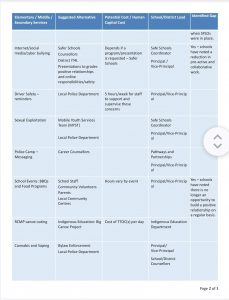 • Additional training cost for Non-Violent Crisis Intervention (CPI).
• Additional training cost for Non-Violent Crisis Intervention (CPI).
• Support for staff dealing with the crisis.
• Delays in receiving supports from police departments nonemergency calls.
• District Youth and Family Counsellor (YFC) and School-Based-Team (SBT) increased caseload.
• Alternatives are not available for a majority of activities.
• Additional program, training, and equipment costs.
• Information around community safety is not being shared in a timely manner.
• Reduction in pro-active and collaborative work around internet/social/media/cyber bullying.
• No longer an opportunity to build a positive relationship on a regular basis.
• Increase in vandalism and graffiti on school grounds.
• Students no longer have an opportunity to learn through a police focused lens.
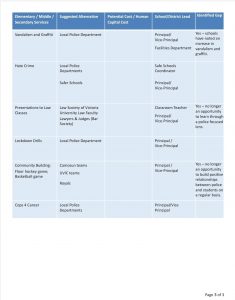 • There is no longer an opportunity to build positive relationships between police and students on a regular basis.
• There is no longer an opportunity to build positive relationships between police and students on a regular basis.
The following programs or presentations are missing from this list that the District provided:
• Gangs in (BC)
• Personal Safety
• Female Personal Safety
• Halloween Safety
• Healthy/unhealthy Relationships
• Human Trafficking
• LGBTQ Presentations
• PARTY program
• Property & Vehicle Crime
• Shoplifting
• Stranger Danger
• Street Drugs
• WITS program
• Mentor individual students
While at present, the Board of Education is certainly within its right to ban SLOs from their schools, community safety falls within provincial and local government jurisdiction. My hope is that the province will step in to rectify what has happened in SD61 through the introduction of legislation or regulation to ensure that such ill informed decisions cannot occur in the future without either provincial approval or consultation with the affected police boards (charged with oversight of policing). Nobody’s interests are served when our collective safety is undermined by poorly thought through decisions that are grounded in nothing more than ideology and virtue signalling.
I wish to offer my sincere thanks to all police officers in our region for their continued service to our community. I can only imagine how decisions like this, based on nonsensical rhetoric and misleading information, affect your morale. Yet the same activists undermining our region’s policing would almost certainly be the first ones to call for your help when a problem arises. Finally, I can’t imagine how police officers feel as they go to pick their children up at school while dressed in uniform knowing that new school district policy requires schools to log when officers are on school property.
Shame on the Greater Victoria School Board.
Privilege, agency, and the climate scientist’s role in the global warming debate
Background
One of the biggest surprises I found upon my return to the University of Victoria after spending 7 1/2 years in the BC Legislature was the overall increase in underlying climate anxiety being experienced by students in my classes. I’ve been teaching at the university level since the mid 1980s and for most of this time, the students in my classes considered global warming to be an esoteric and highly uncertain future threat. While some would express concerns about the growing concentrations of atmospheric greenhouse gases, very few understood, or even cared, how climate change could hypothetically affect them. It was always a problem that others, somewhere else in the world, might have to deal with sometime down the road – but not any more. My experience with this new generation of undergraduates is that they are both very aware of, and deeply troubled by, the threat of global warming. I am beginning to detect a sense of hopelessness and despair within growing numbers of youth. And this troubles me immensely.
For many years I, and my climate science colleagues around the world, spoke truth to power as we continually raised concerns about the ongoing consequences of dumping millions of tons of carbon dioxide into the atmosphere every year. But our warnings fell on deaf ears, or at least ears damaged by the never ending stream of spin, obfuscation and rhetoric being offered up by lobbyists, vested interests, charlatans and others desperate to maintain the fossil-fuel status quo. Yet those days are gone. So much has changed.
Perhaps the most notable increase in public awareness can be attributed to Greta Thunberg and her Skolstrejk för klimatet (School strike for climate). Starting from her lone Friday demonstrations on the steps of the Swedish parliament in August 2018, her movement quickly gained international attention leading to locally-organized Fridays for Future demonstrations around the world (see Figure 1 for images from a Friday, September 19, 2019 demonstration on the lawn of the BC Legislature).
Figure 1 : Four images taken on Friday, September 20, 2019 at a Global Week for Future demonstration on the lawn of the BC Legislature.
At the same time, extreme weather and climate extremes are seemingly becoming the norm rather than the anomaly, with hardly a day going by without a weather disaster somewhere in the world headlining the nightly news. And while in the past, these extreme weather events may have seemed to be someone else’s problem living elsewhere in the world, today no one is immune. Even meteorological terms like “heat domes”, “atmospheric rivers” or the “polar vortex” are becoming commonly used in casual conversation.
The cumulative efforts of so many over so many years in pointing out the importance of curtailing greenhouse gas emissions is finally paying off. Public awareness and desire for action is no longer a barrier to advancing climate policy. For example, one Pew Centre global survey spanning 17 countries in Europe, the Asia-Pacific, and North America indicated that 80% of people surveyed were “willing to make [a lot of or some] changes about how [they] live and work to help reduce the effects of global climate change” (Bell et al., 2021). The greatest barrier, in my view, remains political will. Too many of our elected representatives end up treating politics as a lifelong career instead of a sense of civic duty wherein you step in for a few years, do your part, then step out and let others take over. After a while, one might cynically expect such career politicians to naturally start focusing more on populist and short term policy measures that can successfully be developed and implemented prior to the next election. It would allow that politician to identify short term successes as direct evidence that they were delivering results for their constituents.
By its very nature, climate policy requires a much longer term perspective to be taken. It requires recognition that today’s decision-makers wont have to live the consequences of the climate-related decisions (or lack thereof) that they make. Yet I have always believed that global warming represents the greatest opportunity for innovation, creativity and economic prosperity the world has ever seen since every environmental challenge can also be viewed as an opportunity for innovation and creativity as we seek to address the underlying challenge. Instead of dwelling on the scale of the challenge and hence its apparent hopelessness, which only feeds an individual’s climate anxiety, it can be incredibly empowering to pivot to a focus on developing climate solutions. And herein lies an opportunity for the climate science community.
Climate Anxiety
Climate anxiety is a very real psychological and emotional response to concern about uncertain future climate change impacts (American Psychological Association, 2017, Doherty and Clayton, 2011). Defined as a chronic fear of climate or environmental doom, an individual’s chronic climate anxiety is magnified by extreme weather and climate events that have been experienced personally and/or by those in their close networks.
For example, climate anxiety in North America increased in the summer of 2021 because of intense, record-breaking heatwaves and wildfires (Bratu et al., 2022). As well, increased climate anxiety was almost certainly triggered in those who experienced September 2022’s widespread destruction caused by Hurricane Fiona and Ian’s historic winds, wave activity and storm surge.
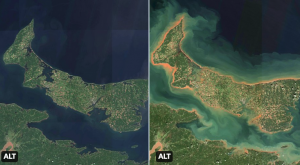 Figure 2: Canadian Space Agency satellite images taken on August 21, 2022 (left) and September 25, 2022 (right). Extensive coastal erosion of Prince Edward Island was caused by historic storm surge and wave activity associated with Hurricane Fiona.
Figure 2: Canadian Space Agency satellite images taken on August 21, 2022 (left) and September 25, 2022 (right). Extensive coastal erosion of Prince Edward Island was caused by historic storm surge and wave activity associated with Hurricane Fiona.
Climate scientists are not immune to climate anxiety. Many within our community have felt compelled to speak out publicly regarding the causes, consequences, and seriousness of global warming. Others have signed petitions, penned letters, written books and commented on social media sites. However, few have actively sought election to government office. This is unfortunate as I continue to believe that political will remains the greatest barrier to advancing climate policy including the decarbonization of global energy systems. But instead of helping to generate that political will, a large cohort of the climate science community, in an attempt to deal with their own climate grief, has heightened rather than alleviated climate anxiety in civil society.
Through this article, I hope to encourage that community to reflect upon the privilege and agency they have to refocus and mobilize their efforts towards advancing climate solutions within society, and to appeal to their sense of civic duty to inspire more to seek elected office. In particular, I argue that:
- Inaccurate scientific messaging associated with the 2018 IPCC Global Warming of 1.5°C report is feeding climate anxiety, and this is leading to despair in youth.
- There are more effective ways for scientists, armed with privilege and agency, to advocate for climate policy than fear-based messaging and civil disobedience.
As Albert Einstein famously noted: “Those who have the privilege to know have the duty to act, and in that action are the seeds of new knowledge.” After reading the rest of this blog, I hope you agree that this quote could be expanded with an additional sentence. “And as the new knowledge grows, the solutions to global warming are revealed.”
Scientific messaging is feeding climate anxiety
The 2018 IPCC Special Report outlining greenhouse gas emission pathways to limit warming to 1.5°C above preindustrial levels (IPCC, 2018) almost certainly contributed to an escalation of overall climate anxiety in recent years. The Special Report was a response to an invitation from signatories to the UNFCC as part of the Paris Agreement. The 2015 Paris Agreement, joined by 193 member states, has the specific goal of:
Holding the increase in the global average temperature to well below 2°C above pre-industrial levels and pursuing efforts to limit the temperature increase to 1.5°C above pre-industrial levels, recognizing that this would significantly reduce the risks and impacts of climate change (UNFCC 2015).
The aspirational 1.5°C target was added in response to lobbying by small island states (and their allies).
While the scientific community responded by outlining pathways to mitigate warming to 1.5°C in (IPCC, 2018), the subtleties embedded within the report seem to have been lost in its dissemination to the public. It is well known that the world has already warmed by 1.2°C since preindustrial times, and if we immediately eliminated all fossil fuel combustion worldwide, we would warm by an additional 0.5°C (IPCC 2021; see Figure 2) as the direct and indirect cooling global effects of aerosols (also associated with fossil fuel combustion) dissipate through gravitational settling and precipitation scavenging. The Earth would warm further as we equilibrate to the present 508 PPM CO2e (NOAA 2022) greenhouse gas loading in the atmosphere, and that is not counting the permafrost carbon feedback which could add another 0.1° to 0.2°C this century to committed warming (Macdougall et al, 2013).
In other words, meeting the 1.5°C target requires an immediate global scale up of negative emissions using technologies that have yet to be developed. Given socioeconomic inertia in our built environment (Matthews and Weaver, 2010), the scale of negative emissions required, and the preponderance of more urgent political priorities (i.e. healthcare, housing, inflation, the economy, the war in Ukraine and so forth), it is not possible for the world to meet the 1.5°C target.
Figure 3: Observed global warming (2010-2019 relative to 1850-1900) and the contribution to this net warming by observed changes to natural and anthropogenic radiative forcing. Reproduced from IPCC (2021).
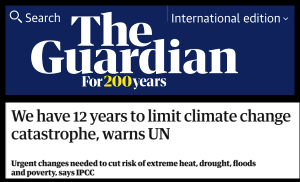 Climate anxiety is also fueled by media messaging related to the perception of a looming climate ‘crisis’ (Crandon et al., 2022). Take the anxiety effect of popular messaging related to the aspirational goal of remaining below a 1.5°C global warming threshold (IPCC, 2018). “We have only 12 years left to limit climate change catastrophe, warns UN” was the headline of a story published in the Guardian on October 8, 2018; “Only 11 years left to prevent irreversible damage from climate change, speakers warn during general assembly high-level meeting” was the headline of a press release issued by the United Nations on March 28, 2019 during its 73rd session (UN, 2019); “Climate change: 12 years to save the planet? Make that 18 months” was the headline of a BBC News story on July 24, 2019 (BBC, 2019).
Climate anxiety is also fueled by media messaging related to the perception of a looming climate ‘crisis’ (Crandon et al., 2022). Take the anxiety effect of popular messaging related to the aspirational goal of remaining below a 1.5°C global warming threshold (IPCC, 2018). “We have only 12 years left to limit climate change catastrophe, warns UN” was the headline of a story published in the Guardian on October 8, 2018; “Only 11 years left to prevent irreversible damage from climate change, speakers warn during general assembly high-level meeting” was the headline of a press release issued by the United Nations on March 28, 2019 during its 73rd session (UN, 2019); “Climate change: 12 years to save the planet? Make that 18 months” was the headline of a BBC News story on July 24, 2019 (BBC, 2019).
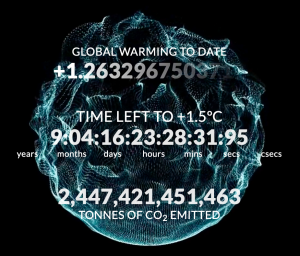 To amplify the urgency of further climate action, “Climate Clocks” were developed that purported to count down days until it was too late to avoid the worst impacts of global warming (see here and here). It is unclear how watching a countdown to catastrophe would do anything other than increase climate anxiety and instill a sense of hopelessness and despair. Political rhetoric from those with large followings, such as when Rep. Alexandria Ocasio-Cortez proclaimed “The world is going to end in 12 years if we don’t address climate change” (USA Today, 2019), also contributes to increasing climate anxiety.
To amplify the urgency of further climate action, “Climate Clocks” were developed that purported to count down days until it was too late to avoid the worst impacts of global warming (see here and here). It is unclear how watching a countdown to catastrophe would do anything other than increase climate anxiety and instill a sense of hopelessness and despair. Political rhetoric from those with large followings, such as when Rep. Alexandria Ocasio-Cortez proclaimed “The world is going to end in 12 years if we don’t address climate change” (USA Today, 2019), also contributes to increasing climate anxiety.
![]() Inherent in the 12 years left narrative, and the IPCC 1.5°C report is the implied notion that there is something magical about the number 1.5°C. Of course, there is no scientific rationale to justify an acceptable warming threshold of 1.5°C instead of 1.3°C or 1.672°C. Any defined level of ‘acceptable’ warming obviously involves an assessment of societal values and those will clearly be different depending on where you live in the world.
Inherent in the 12 years left narrative, and the IPCC 1.5°C report is the implied notion that there is something magical about the number 1.5°C. Of course, there is no scientific rationale to justify an acceptable warming threshold of 1.5°C instead of 1.3°C or 1.672°C. Any defined level of ‘acceptable’ warming obviously involves an assessment of societal values and those will clearly be different depending on where you live in the world.
In fact, even the 2°C threshold for acceptable warming originally only entered the public arena shortly after the IPCC released its Second Assessment Report and prior to the establishment of the Kyoto Protocol. In 1996, the Council of the European Union concluded:
The Council recognizes that, according to the IPCC S.A.R., stabilization of atmospheric concentrations of CO2 at twice the pre-industrial level, i.e. 550 ppm, will eventually require global emissions to be less than 50% of current levels of emissions; such a concentration level is likely to lead to an increase of the global average temperature of around 2°C above the pre-industrial level.
And:
Given the serious risk of such an increase and particularly the very high rate of change, the Council believes that global average temperatures should not exceed 2 degrees above pre-industrial level and that therefore concentration levels lower than 550 ppm CO2 [carbon dioxide] should guide global limitation and reduction efforts. This means that the concentrations of all greenhouse gases should also be stabilized. This is likely to require a reduction of emissions of greenhouse gases other than CO2 in particular CH4 [methane] and NO2 [sic; nitrous oxide].
Ironically, it was inconsistent on the one hand, for the EU Council to advocate for carbon dioxide to be stabilized at or below 550 ppm with emissions eventually dropping to less than 50% of 1996 levels, while on the other hand, arguing for the 2°C threshold not to be exceeded.
While ambitious goal-setting can in theory be an effective motivator of action (Locke and Latham, 2002), in practice, alarmist media reframing (Ereaut and Segnit, 2006) of failure to remain below the 1.5°C goal into a scenario of impending doom has become quintessential fuel for personal climate anxiety. Taken in the collective across society, climate anxiety driven by personal concern and amplified by poorly calibrated media messaging is quickly emerging as a dominant factor in the collective zeitgeist of the Anthropocene (e.g. Crutzen 2006, Hickman et al 2021, Wray 2022).
Given that most of today’s decision-makers will not be around to be held accountable for their action, or lack thereof, towards meeting various targets set well into the future, a more appropriate framing and scientifically justifiable statement is for society to collectively do what we can to avoid as much warming as possible. Every tenth of a degree warming avoided reduces our collective climate risk and, by corollary, our overall collective climate anxiety.
But this still doesn’t address how individual climate anxiety can be reduced.
A far more constructive approach would be for the scientific community to turn our collective attention to climate solutions, not climate fear mongering or climate alarmism. Take the recent viral Tik Tok video showing Nasa Scientist Dr. Peter Kalmus prior to getting arrested after chaining himself to a JP Morgan Chase building in Los Angeles. The emotion in Dr. Kalmus’ voice indicates that he is likely dealing with his own climate anxiety, but I question whether or not the message in his viral video did anything more than increase the level of anxiety within children and youth worldwide:
“So, I am here because scientists are not being listened to. I am willing to take a risk for this gorgeous planet. That sucks, and we’ve been trying to warn you guys for so many decades now we are heading towards a catastrophe. And we are being ignored, the scientists of this world are being ignored, and it’s got to stop. We are going to lose everything, and we are not joking. We are not lying; we are not exaggerating. This is so bad everyone that we are willing to take this risk and more and more scientists, and more and more people are going to be joining us. This is for all the kids of the world — all of the young people, all of the future people. This is so much bigger than any of us. It’s time for all of us to stand up and take risks and make sacrifices for this beautiful planet that gives us life.”
At no point were any solutions posed, any positive actions suggested, or any personal climate risk reduction advocated for. The scientists involved likely believed that they were raising public awareness of the seriousness of global warming. Yet I argue that these same scientists abdicated their position of power and privilege by inadvertently pretending to be on the same footing as those most affected by climate change. In doing do, the scientists did little more than stoke the fires of climate anxiety when they had agency to facilitate constructive change both within their public engagements, as well as their own personal choices.
It’s also long been known that fear based messaging does not work in terms of motivating personal climate action (e.g., O’Neill and Cole (2009) , Stern (2012), Climate Tracker (2017). In fact, many simply disassociate themselves from the issue. Others, of course, take the fear to heart and it feeds their underlying climate anxiety.
Articles like McKay et al., 2022, with provocative, if not highly speculative, titles may attract media attention in the lead up to an annual UNFCCC COP event. But they are often framed as opinion or expert assessment and so are often highly controversial and not representative of broad scientific consensus. Extremely low probability, perhaps even impossible, but certainly poorly understood tipping point scenarios often end up being misinterpreted as likely and imminent climate events. The nuances of scientific uncertainty, the differences between hypothesis posing vs hypothesis testing, and the proverbial “implications of this work” throw away statements, wherein scientists take creative license with speculative possibilities, are all lost on the lay reader as the study goes viral across social media.
More recently, some activists have even called on the scientific community to engage in more civil disobedience (e.g., Capstick et al., 2022, Earth.org, 2022) arguing that it is effective and leads to change. Once more, I am not sure how activist scientists with agency help advance the necessary solutions and believe that the time for such activism has long passed. Governments around the world have committed to climate action but are struggling to advance the various solutions required for the low carbon economies of tomorrow. They need help, ideas, solutions and ongoing support and the scientific community is ideally positioned to assist in this regard.
In fact, many look to the climate science community for leadership on greenhouse gas mitigation and do so with dismay when they see these same scientists jetting off to various conferences, UNFCCC COP/IPCC meetings and workshops at exotic locations around the world. How many thousands of people attended the 26th Conference of Parties meeting of the United Nations Framework Convention on Climate Change in Glasgow in 2021? How many attended the 27th meeting in Sharm el-Sheikh in 2022? Was their presence really necessary? Climate scientists, with their privilege and agency, not only have a responsibility to assist identifying and implementing climate solutions; they also need to model the climate leadership they are calling on others to follow. Failing to do so sends the wrong message, a message that undermines the prevailing narrative that we are in a “climate emergency”.
More effective ways for scientists to advocate for climate policy
The climate science community operates from a position of privilege in the public discourse of climate change science, its impacts and solutions. Whether it be by participating in the writing of IPCC reports or our own research, climate scientists have defined the scale of the global warming challenge, outlined pathways to decarbonization of our energy systems, and documented a suite of future impacts, many of which would be very detrimental to future societies. We’ve also quantified the climate risk to our natural and built environment. Armed with this knowledge, climate scientists, more than most, are well-informed and so have agency in the advancement of climate solutions. But when climate scientists participate in civil disobedience or do little more than criticize others for inaction, they abdicate that position of privilege and agency by pretending to be on the same footing as others in society who are not as well informed on the nuances of climate change. As such, rather than alleviating their own, and broader society’s, climate anxiety, they fuel it further by inadvertently ratcheting up the rhetoric with nothing to offer in terms of overall solutions or risk reduction. I firmly believe that the climate science community has a duty and responsibility to become more actively engaged in the delivery of climate solutions in whatever form they feel most comfortable work with (i.e., nature-based, technological, socioeconomic or policy solutions).
At the same time, the scientific community must be reminded that they are but one stakeholder in the global warming debate. Whether or not society wishes to respond to the challenge of global warming really boils down to one question. Do we the present generation owe anything to future generations in terms of the quality of the environment we leave behind? Yes or No? Science cannot answer this question; but it can help articulate the expected consequences of action or inaction. Science can also inform decision makers by pointing out that if the answer to the above question is yes, dramatic GHG reductions (both through the decarbonization of energy systems and the introduction of negative emission technology) must commence now. Waiting until the future to start reducing emissions means waiting until it is too late.
While the answer to the above question is fundamentally personal, most almost certainly would respond yes, particularly those who have children. Yet some would disagree. For example, “Some evangelicals argue that global warming is of little concern when the end times are approaching. Indeed, it could even be proof of it” (Gander, 2019); Fatalists may believe that what will occur in the future is inevitable, perhaps even a manifestation of God’s will, and so believe that an individual’s actions or choices will have no effect on the direction we are heading. Libertarians may focus on the importance of individual freedoms, express concern about government overreach and regulation and may advocate for a laissez-faire approach to climate policy. There might be some who might answer yes to question, but their deep suspicion of environmentalists may make them question the urgency of dealing with global warming. Then of course there are those who will have been swept up in the various conspiracy theories so prevalent on the internet these days. Fortunately, the Pew survey cited above (Bell et al., 2021) allows us to estimate that it is only about 20% of the population who will likely object to the advancement of climate policy. And so, I am of the firm belief that engaging with this audience is counter-productive and a waste of a climate scientist’s time.
Instead of trying to persuade the unpersuadable, participating in civil disobedience or publicly demanding government take unspecified actions it would be far more productive if the scientific community, turned their attention to the development and advancement of climate solutions. This can be accomplished in any one of a number of ways. For example:
- Supporting progressive government policy vocally and publicly once it has been introduced;
- Running for office;
- Advocating for constructive solutions in recognition that we have agency and we occupy a position of privilege in society.
Given the emergence of social media in this post-truth age we are seeing more and more populist policies globally wherein decisions are made first, and then evidence (real or imagined) is sought after the fact to support an ideological agenda — this is what I call decision-based evidence-making, the antithesis to the scientific method. Scientists are driven by the quest to understand the world around us. We are driven by evidence. We identify problems and then take steps to solve these problems using reproducible techniques. Central to who we are as scientists is the notion of evidence-based decision-making. We understand this notion and react strongly to decision-based evidence-making, the antithesis to the scientific method. I truly believe our community has an inherent responsibility to exhibit the necessary leadership (especially through our own behaviour) to ensure that we play a constructive role in identifying solutions to the environemental problem that we have spent so many decades studying.
Finally, a co-benefit our community will warmly welcome in the move towards a climate-solutions focus, is the amelioration of our own climate anxiety (not to mention broader societal climate anxiety). I say this from personal experience, having worked in the field since the 1980s. Climate scientists, like others in the general public, often also struggle with the notion of climate anxiety and grief. But unlike others in the general public, our community holds agency and a position of privilege in the global warming debate. Rather than denying this agency and privilege I am hopeful that as a community we will collectively rise to the myriad opportunities global warming has afforded us for constructive public engagement and the betterment of society.
In the weeks ahead, I hope to expand upon these initial ideas by offering more concrete examples of engagement and responding to any feedback coming my way from this post.
Congratulations to all 2020 Oak Bay Young Exceptional Star (Y.E.S.) Award Winners
 On Thursday last week the 13th annual Oak Bay Young Exceptional Star (Y.E.S) awards ceremony was held at the Oak Bay Beach Hotel. Ten exceptionally talented youth in grades 6 to 10 were honoured for their achievements.
On Thursday last week the 13th annual Oak Bay Young Exceptional Star (Y.E.S) awards ceremony was held at the Oak Bay Beach Hotel. Ten exceptionally talented youth in grades 6 to 10 were honoured for their achievements.
As noted by the YES Awards Committee, Chaired by Hazel Braithwaite, that administers the awards, “The goal of the awards is to emphasize the positive achievements of Oak Bay’s young people by recognizing those who have distinguished themselves in such areas as volunteerism, arts, citizenship, academics, athletics and/or who have overcome obstacles to achieve their goals.”
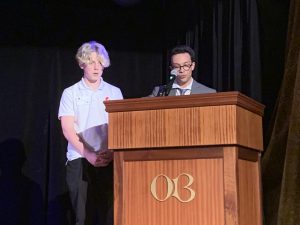 Congratulations to this year’s award winners: Owen Barlow, Anna Friesen, Olivia Friesen, Jennifer Lambert, Amelia Leibel, Mason Levin, Beatrice Sharpe, Panos Tzanetakis, Alice Wu and Kyla Younger.
Congratulations to this year’s award winners: Owen Barlow, Anna Friesen, Olivia Friesen, Jennifer Lambert, Amelia Leibel, Mason Levin, Beatrice Sharpe, Panos Tzanetakis, Alice Wu and Kyla Younger.
I had the pleasure of presenting the award to Owen Barlow from Monterey Middle School who was nominated by his teacher Mr. Mallet. Unfortunately I was unable to be at the event in person so Noah Conrad, a former Oay Bay High School graduate and legislative research assistant in my office, kindly volunteered to present the award on my behalf.
Below is the text of his presentation speech.
Text of Presentation Speech
Teacher Mr. Mallet says that It is with the greatest of enthusiasm that he nominates Owen Barlow for an Oak Bay Young Exceptional Star Award. He is nominating Owen is in the area of Athletics.
Owen is a grade eight student at Monterey Middle School and an active member of the local rugby community. Owen plays rugby for James Bay Athletic Association–often times at a higher division than other players his age–as well as Team BC U16 Elite 7s, and VIRU Tide Rugby–a rep team that competes annually in the Pacific Rugby Championships.
Owen is thought to be one of the top players at his position for his age in the province, and has been invited to play with the Waikiki Beach Boys in a 15’s tournament that takes place in Oahu, Hawaii later this year.
In school, Owen is an active member of the Sr. Boys Basketball and Rugby teams. Last year, Owen played rugby for both the Jr. and Sr. Boys teams, winning a city championship with the Jr. Team, and a 3rd place finish with the Sr. Boys. Owen is looking forward to his final season of Monterey Rugby, and the ability to compete for a City Championship at the Sr. Boys level.
Academically, Owen does his best to maintain a B average while trying to manage his extensive, but valuable rugby commitments. Further, Owen is a leader among his peers and is willing to work alongside anybody in his class.
Owen has garnered the respect of his teachers and coaches, as he demonstrates a highly developed work ethic as well as an ability to put forth 100% effort in all of his athletic pursuits.
Mr. Mallet feels Owen is a talented athlete with natural leadership ability, who is destined to achieve great things. We agree and are so very pleased to be able to present him with a Young Exceptional Star award this year – please help me congratulate him!
24 hours of climate reality: A presentation at Oak Bay High
Today marks the beginning of the 24 Hours of Reality: Truth in Action initiative led by Al Gore’s Climate Reality Project. 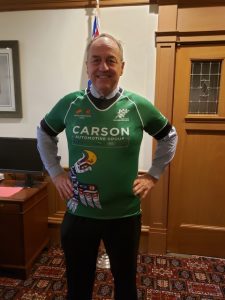 Around the world, more than 1700 lectures, with follow-up discussions, are being given to hundreds of thousands of people. I had the pleasure of attending a presentation by Climate Reality Lead Mentor for BC Judy Fainstein (trained by Al Gore in 2008) and Stefan Jonsson, Climate Reality leader (trained by Al Gore in 2019) at Oak Bay High’s Dave Dunnet Community Theatre this morning.
Around the world, more than 1700 lectures, with follow-up discussions, are being given to hundreds of thousands of people. I had the pleasure of attending a presentation by Climate Reality Lead Mentor for BC Judy Fainstein (trained by Al Gore in 2008) and Stefan Jonsson, Climate Reality leader (trained by Al Gore in 2019) at Oak Bay High’s Dave Dunnet Community Theatre this morning.
Following the presentation, I served on a panel with grade 12 student Emma-Jane Burian and grade 9 student Grace Sinats. Readers will know that these two remarkable youth are leaders in the Victoria Chapter of Climate Strike Canada.
What impressed me most about this event was the incredibly thoughtful, insightful and substantive questions posed to the panel by the several hundred youth in the crowd. And listening to answers provided by Grace and Emma-Jane left me with a feeling that as a society, we will be in good hands as these remarkable youth emerge as the decision-makers of tomorrow.
After the event I was presented with a newly designed (by Richard Hunt) Oak Bay Barbarians rugby jersey. I am proudly fashioning the jersey to the right and in the video below, after I introduce a delegation of visitors from the local Taiwanese community, I poke fun at the Premier (who went to Reynolds High School) during the Member Introductions portion of today’s legislative sitting.

